Abstract
The value of a QRS scoring system derived from 12 lead electrocardiograms to estimate left ventricular ejection fraction was assessed in a prospective study of 285 hospital survivors of myocardial infarction. In these patients both the QRS score and ejection fraction were measured by radionuclide ventriculography at discharge. The correlation between ejection fraction and QRS score was weak. In 22 patients who died during six to 12 months follow up the ability of the ejection fraction and QRS score to predict mortality was assessed in terms of sensitivity, specificity, predictive value of a positive and negative test, and efficiency. For ejection fraction less than 40% and a QRS score greater than or equal to 6 sensitivity was respectively 73% and 64%, specificity 73% and 56%, predictive value of a positive test 18% and 11%, predictive value of a negative test 97% and 95%, and efficiency 73% and 56%. Both ejection fraction and QRS score may be used to identify patients at low and high risk during one year follow up, but, contrary to initial expectations, the QRS score appears to be of little value in estimating ejection fraction and is less accurate than ejection fraction in predicting late survival in hospital survivors of myocardial infarction.
Full text
PDF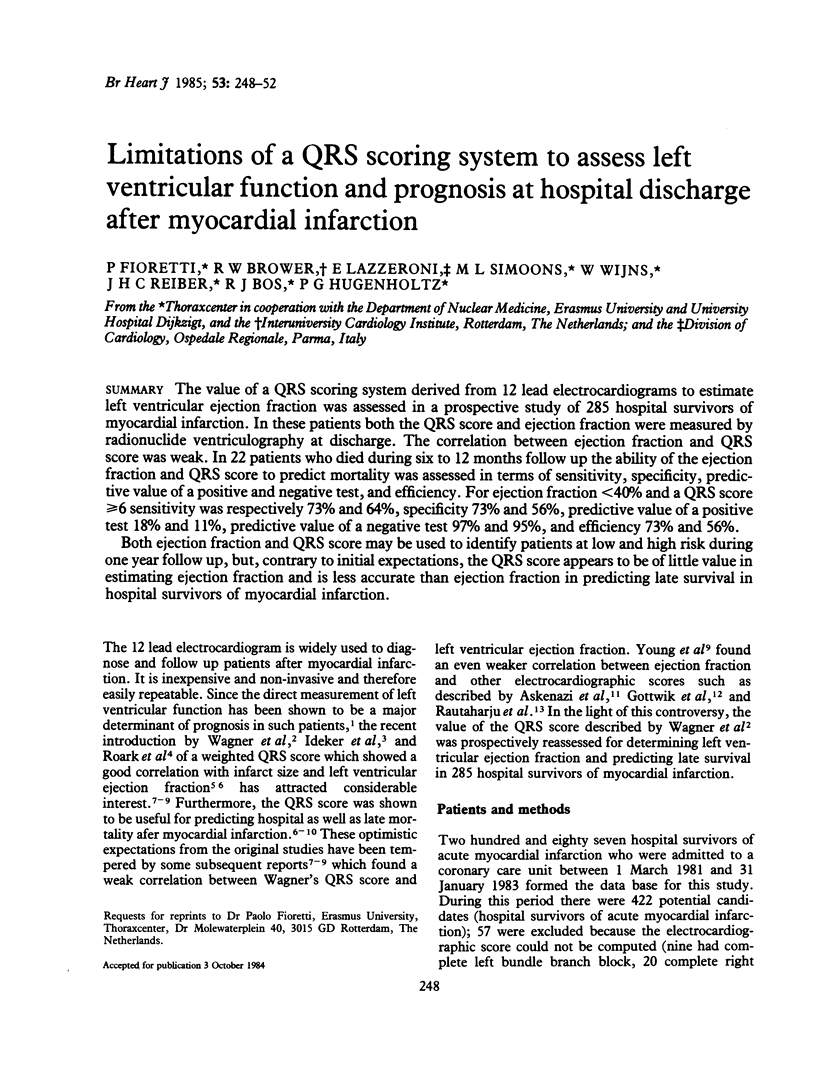
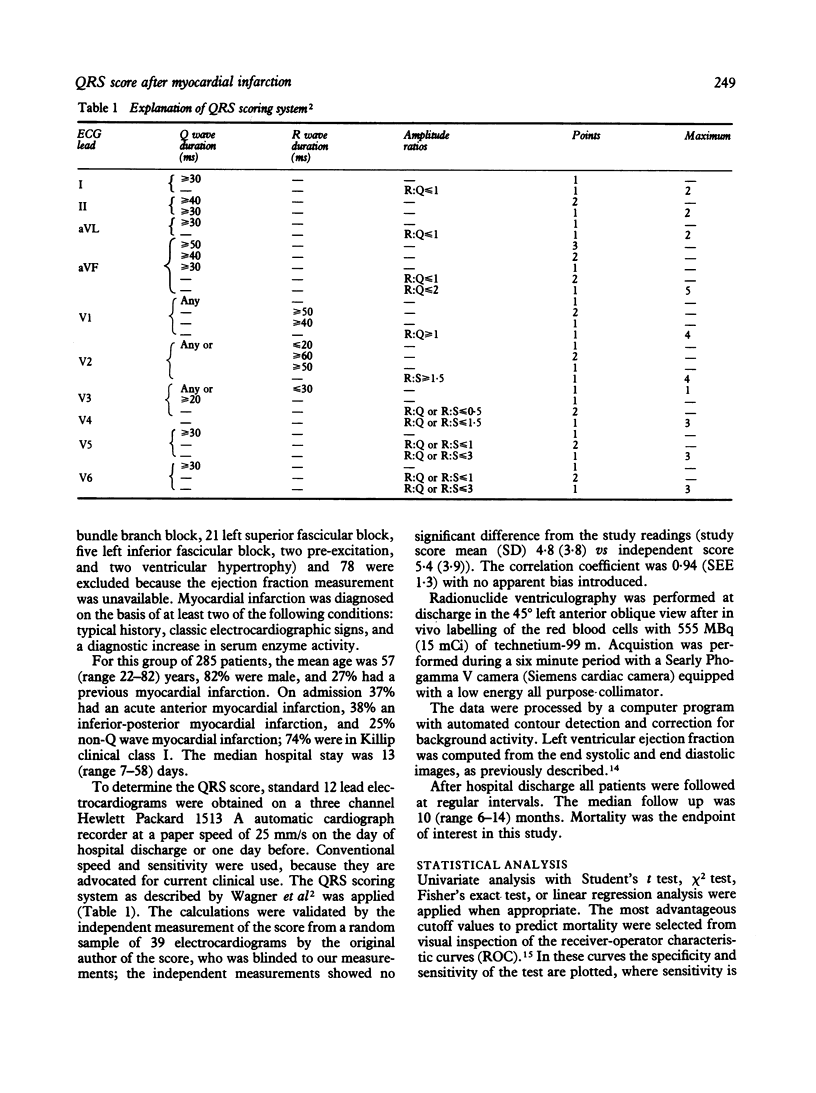
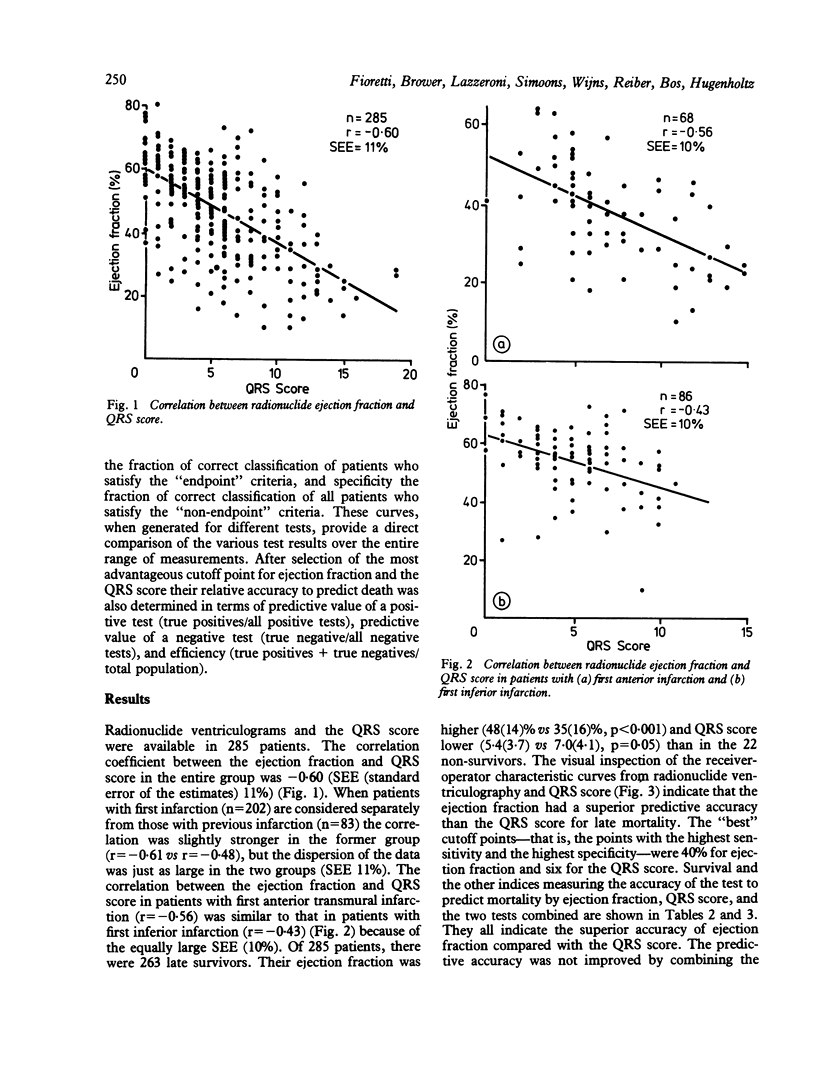
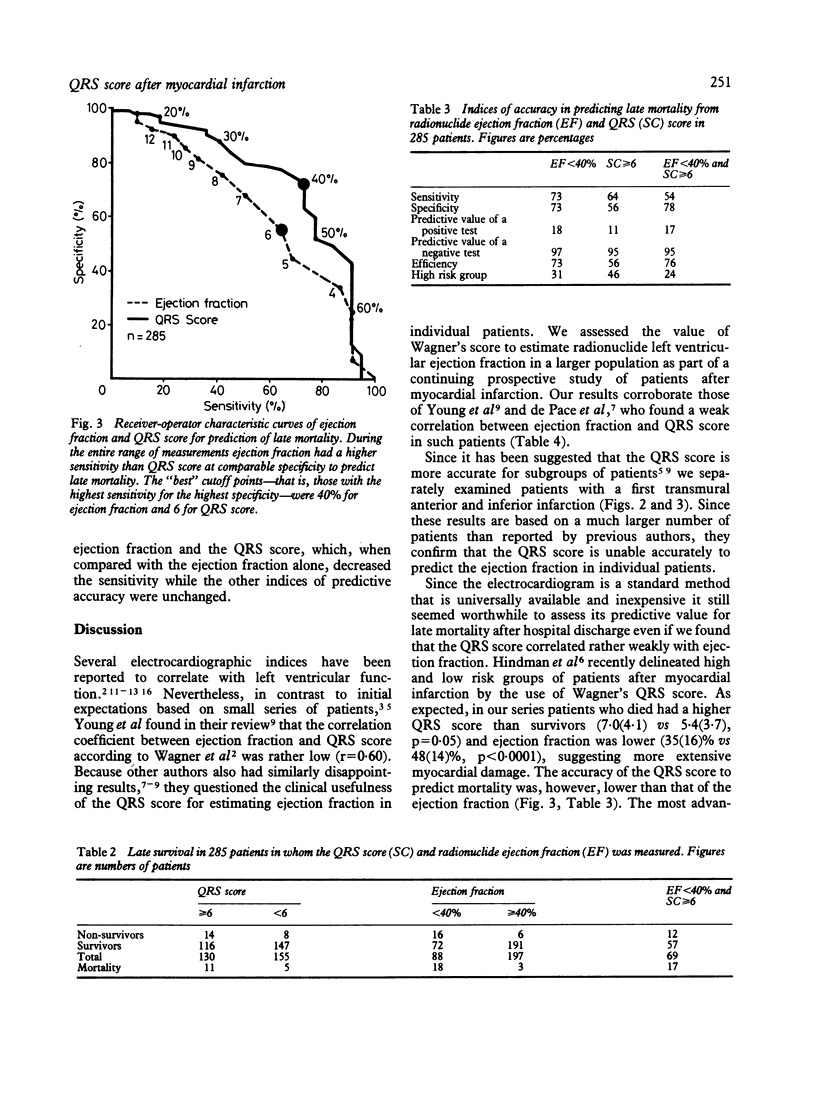
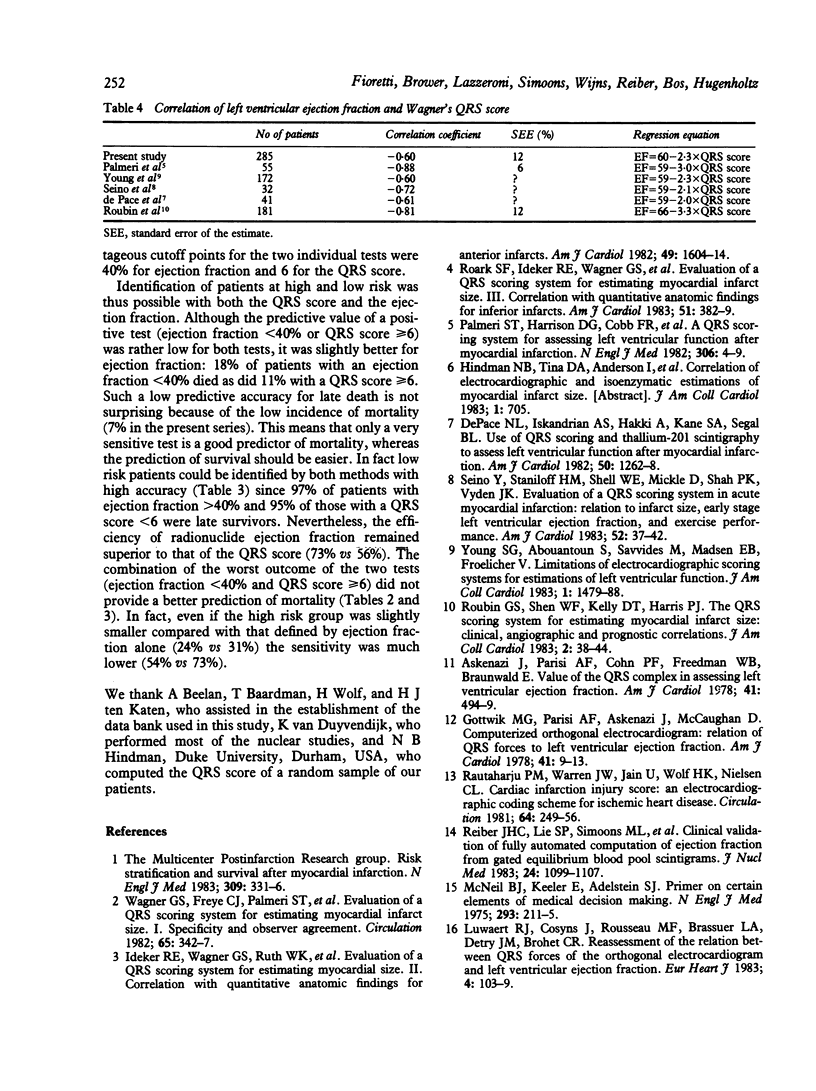
Selected References
These references are in PubMed. This may not be the complete list of references from this article.
- Askenazi J., Parisi A. F., Cohn P. F., Freedman W. B., Braunwald E. Value of the QRS complex in assessing left ventricular ejection fraction. Am J Cardiol. 1978 Mar;41(3):494–499. doi: 10.1016/0002-9149(78)90005-x. [DOI] [PubMed] [Google Scholar]
- DePace N. L., Iskandrian A. S., Hakki A. H., Kane S. A., Segal B. L. Use of QRS scoring and thallium-201 scintigraphy to assess left ventricular function after myocardial infarction. Am J Cardiol. 1982 Dec;50(6):1262–1268. doi: 10.1016/0002-9149(82)90460-x. [DOI] [PubMed] [Google Scholar]
- Gottwik M. G., Parisi A. F., Askenazi J., McCaughan D. Computerized orthogonal electrocardiogram: relation of QRS forces to left ventricular ejection fraction. Am J Cardiol. 1978 Jan;41(1):9–13. doi: 10.1016/0002-9149(78)90125-x. [DOI] [PubMed] [Google Scholar]
- Ideker R. E., Wagner G. S., Ruth W. K., Alonso D. R., Bishop S. P., Bloor C. M., Fallon J. T., Gottlieb G. J., Hackel D. B., Phillips H. R. Evaluation of a QRS scoring system for estimating myocardial infarct size. II. Correlation with quantitative anatomic findings for anterior infarcts. Am J Cardiol. 1982 May;49(7):1604–1614. doi: 10.1016/0002-9149(82)90235-1. [DOI] [PubMed] [Google Scholar]
- Luwaert R. J., Cosyns J., Rousseau M. F., Brasseur L. A., Detry J. M., Brohet C. R. Reassessment of the relation between QRS forces of the orthogonal electrocardiogram and left ventricular ejection fraction. Eur Heart J. 1983 Feb;4(2):103–109. doi: 10.1093/oxfordjournals.eurheartj.a061423. [DOI] [PubMed] [Google Scholar]
- McNeil B. J., Keller E., Adelstein S. J. Primer on certain elements of medical decision making. N Engl J Med. 1975 Jul 31;293(5):211–215. doi: 10.1056/NEJM197507312930501. [DOI] [PubMed] [Google Scholar]
- Palmeri S. T., Harrison D. G., Cobb F. R., Morris K. G., Harrell F. E., Ideker R. E., Selvester R. H., Wagner G. S. A QRS scoring system for assessing left ventricular function after myocardial infarction. N Engl J Med. 1982 Jan 7;306(1):4–9. doi: 10.1056/NEJM198201073060102. [DOI] [PubMed] [Google Scholar]
- Rautaharju P. M., Warren J. W., Jain U., Wolf H. K., Nielsen C. L. Cardiac infarction injury score: an electrocardiographic coding scheme for ischemic heart disease. Circulation. 1981 Aug;64(2):249–256. doi: 10.1161/01.cir.64.2.249. [DOI] [PubMed] [Google Scholar]
- Reiber J. H., Lie S. P., Simoons M. L., Hoek C., Gerbrands J. J., Wijns W., Bakker W. H., Kooij P. P. Clinical validation of fully automated computation of ejection fraction from gated equilibrium blood-pool scintigrams. J Nucl Med. 1983 Dec;24(12):1099–1107. [PubMed] [Google Scholar]
- Roark S. F., Ideker R. E., Wagner G. S., Alonso D. R., Bishop S. P., Bloor C. M., Bramlet D. A., Edwards J. E., Fallon J. T., Gottlieb G. J. Evaluation of a QRS scoring system for estimating myocardial infarct size. III. Correlation with quantitative anatomic findings for inferior infarcts. Am J Cardiol. 1983 Feb;51(3):382–389. doi: 10.1016/s0002-9149(83)80069-1. [DOI] [PubMed] [Google Scholar]
- Roubin G. S., Shen W. F., Kelly D. T., Harris P. J. The QRS scoring system for estimating myocardial infarct size: clinical, angiographic and prognostic correlations. J Am Coll Cardiol. 1983 Jul;2(1):38–44. doi: 10.1016/s0735-1097(83)80374-x. [DOI] [PubMed] [Google Scholar]
- Seino Y., Staniloff H. M., Shell W. E., Mickle D., Shah P. K., Vyden J. K. Evaluation of a QRS scoring system in acute myocardial infarction: relation to infarct size, early stage left ventricular ejection fraction, and exercise performance. Am J Cardiol. 1983 Jul;52(1):37–42. doi: 10.1016/0002-9149(83)90065-6. [DOI] [PubMed] [Google Scholar]
- Wagner G. S., Freye C. J., Palmeri S. T., Roark S. F., Stack N. C., Ideker R. E., Harrell F. E., Jr, Selvester R. H. Evaluation of a QRS scoring system for estimating myocardial infarct size. I. Specificity and observer agreement. Circulation. 1982 Feb;65(2):342–347. doi: 10.1161/01.cir.65.2.342. [DOI] [PubMed] [Google Scholar]
- Young S. G., Abouantoun S., Savvides M., Madsen E. B., Froelicher V. Limitations of electrocardiographic scoring systems for estimation of left ventricular function. J Am Coll Cardiol. 1983 Jun;1(6):1479–1488. doi: 10.1016/s0735-1097(83)80052-7. [DOI] [PubMed] [Google Scholar]


